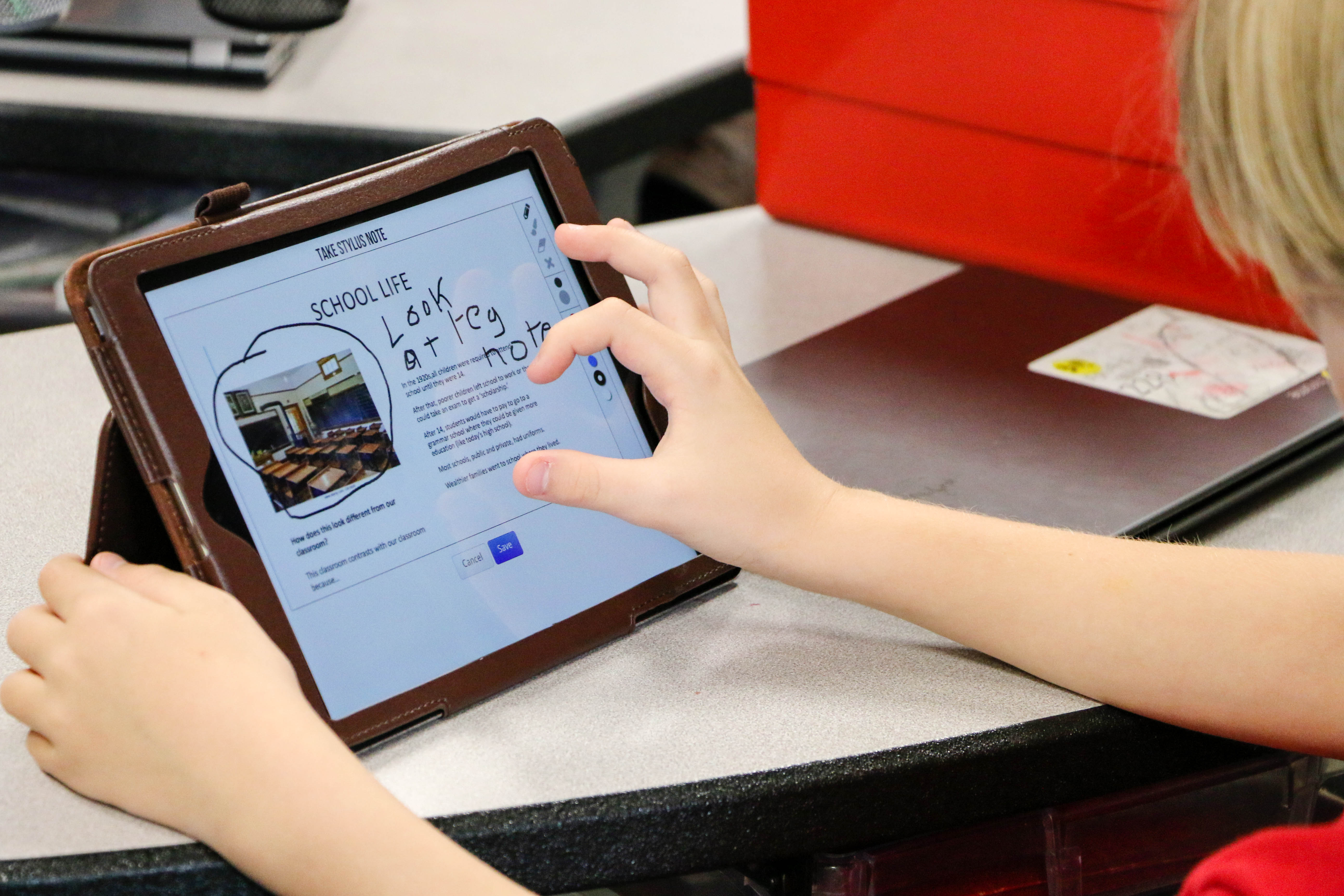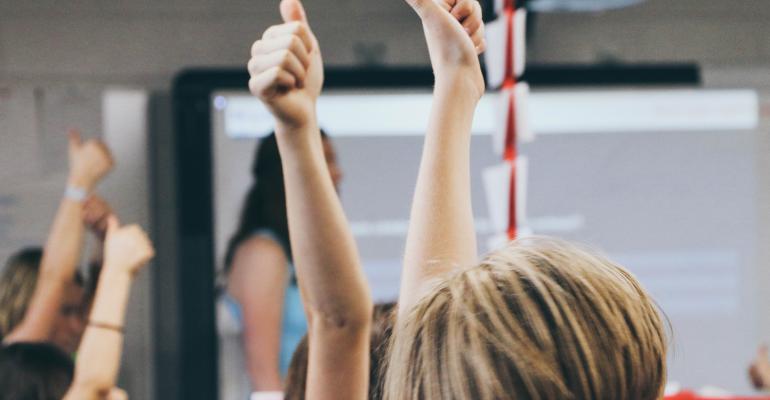As a fourth-grade teacher, I am increasingly impressed with all the things my scholars find more interesting than me—wooden pencil shards, the omnipresent Pokeman card, and, most recently, a superbly obnoxious fidget spinner. As a first-year teacher, I also engage in various forms of “professional development” because, God knows, I need it. I’ve been learning about forging student relationships, enhancing content, and, most recently, about how to inspire active student engagement.
But what I really wanted to know is how we can fix what ails those who are bitten by the disinterest bug. How can I make my lessons a more engaging, interactive, and digital experience? Perhaps there’s something happening in the adult education world I could adapt for my classroom.
Then the folks at Educational Measures offered to bring in some of their second-screen meeting technology, equipped with Array software, in an experimental effort to observe how 10-year-olds would interact with a program often used by adults. We wanted to see if adding new technology into my classroom—polling questions, open-ended discussion questions, options to rate and annotate slides—would boost the overall engagement among my students.
The Setup
After shuffling my students off to art class, I sat down with the EM experts to work on my presentation. The topic was the women’s suffrage movement, including Susan B. Anthony and the stubborn social norms of the 1920s. I had some pre-test/post-test questions in mind, and I chose where they would be inserted and if a question should be open-ended or multiple choice. The most exciting part was that both students and I would get to visually see the how their responses compared to the rest of the class.
The team gave me a quick run-through of the presenter tech, including a small remote I would use to change slides and an iPad to see any questions sent to me during the lesson
Enter the Kids
The students’ faces lit up with giddy and goofy smiles as they admired the sleek iPad now occupying each of their desks. After a short tutorial on how to annotate, rate, and save slides, and ask questions, we got started.
During my morning presentation, there were slides where students compared and contrasted modern pictures with those of 1920. After having the chance to converse, they answered the same question in writing on the next slide. They all were eager to share what they discussed at their table, and allowing them to type out their answers to display to the class definitely boosted their confidence. When the organized list of open-responses (some misspelled, some short, some long) were put on the big screen, squeals rippled through the room as each tried to find his or her own answer and read those of classmates. Tinkering with the program was instinctual for these ravenous learners, and they absolutely loved it.
As the presentation continued, I fed off of their energy, and I became more comfortable navigating the software. I was more aware of the questions to come, and I attempted to frontload as much as possible on the content that would be covered in the following slide.
Before discussing boys’ clothing, for instance, students were asked to answer a true/false question: “Boys traditionally wore full-length pants.” The discussion before was fun, but as they learned the answer in the proceeding slide, they were ready to respond again. We were all fascinated to see how everyone’s thinking shifted from pre-test to post-test.
Honing the Experience
Once I dismissed my morning class to lunch, I was anxious to reflect and do it again with my afternoon munchkins.
I decided to be more intentional about explaining how the before and after questions were valuable tools to measure learning. As my new group of scholars zigzagged to their seats after lunch, I did it all again. When a pre-test slide appeared, I said, “I don’t expect you to know this now, but I want you to listen. After the next slide, maybe your thinking will shift.” And it usually did.
 Towards the end of the PowerPoint, we discussed what a hope chest was, and I asked students to make a connection between the use of a hope chest and what it suggested about women of the 1920s. In my morning class, I realized I had not allowed enough discussion on this topic and my explanation was not adequate. They still felt that women were “encouraged to follow their dreams” during this era.
Towards the end of the PowerPoint, we discussed what a hope chest was, and I asked students to make a connection between the use of a hope chest and what it suggested about women of the 1920s. In my morning class, I realized I had not allowed enough discussion on this topic and my explanation was not adequate. They still felt that women were “encouraged to follow their dreams” during this era.
For my second group, though, I let the kids dive in as they shared with the class how being given a hope chest, for linens and household objects, assumed that a woman’s future depended only on whom she married. When I asked the question, “What does this tell us about how women thought of their future in 1920?”, 88 percent of my afternoon class answered correctly. A little reflection, adjustment, and discussion went a long way.
Both presentations captivated the kids, and we only needed to squeeze in one jumping-jack “brain-break.” I watched as question upon question popped up on my iPad screen. I saw kids drawing and taking notes, and their trigger-happy fingers were always leaping to answer the next question. It was not a traditional monotone presenter-to-audience interaction; it was a learner-to-learner relationship with second-screen technology serving as the graceful bridge.
After the presentation ended and our EM guests packed up their gear, I asked my students what they enjoyed most about using the technology. One of my fourth graders, Jack, who is a notorious magnet for distraction, said, “What I liked was how we each had our own iPads. I liked how there were many slides and that we got to answer questions instead of answer them on paper.”
His reflection was not only thoughtful and mature, but also very telling. Kids know when they are truly engaged, and they are not afraid to say when they are not. I know this experience will stick with these kids.
By approaching learning with the honesty and curiosity of a fourth grader, I believe adapting to the constant stream of new technology is not only possible but fun. Engagement stems from allowing learners to actually witness the expanse of their knowledge, like watching a marshmallow balloon in a microwave. Knowing my audience enabled me to intrinsically motivate scholastic improvement through active experience with meeting industry technology. The best part was that none of it felt like work.
Madison Stockton is a first-year teacher currently teaching fourth-grade literacy at Southmoor Elementary in Denver. She is a big proponent of self-directed and reflective learning, and she tries to encourage this with all of her students. She is involved in the Imaginarium team at Denver Public Schools whose mission is to stimulate and support innovation across Denver public education systems.





